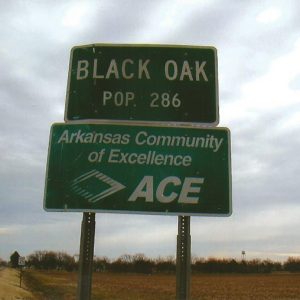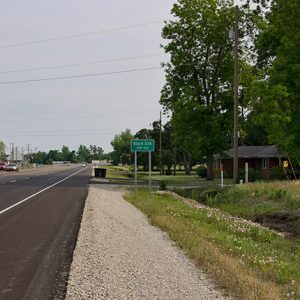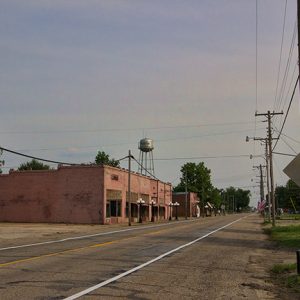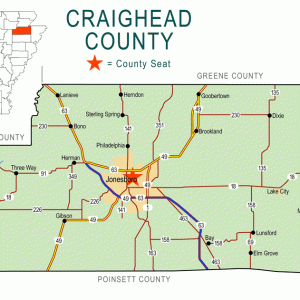calsfoundation@cals.org
Black Oak (Craighead County)
| Latitude and Longitude | 35°50’20″N 090°22’05″W |
| Elevation: | 230 feet |
| Area: | 0.42 square miles (2020 Census) |
| Population: | 233 (2020 Census) |
| Incorporation Date: | December 24, 1923 |
Historical Population as per the U.S. Census:
|
1810 |
1820 |
1830 |
1840 |
1850 |
1860 |
1870 |
1880 |
1890 |
1900 |
|
– |
– |
– |
– |
– |
– |
– |
– |
– |
– |
|
1910 |
1920 |
1930 |
1940 |
1950 |
1960 |
1970 |
1980 |
1990 |
2000 |
|
– |
– |
302 |
329 |
261 |
220 |
272 |
309 |
277 |
286 |
|
2010 |
2020 |
|
|
|
|
|
|
|
|
|
262 |
233 |
|
|
|
|
|
|
|
The northeast Arkansas town of Black Oak, one of three Arkansas communities so named, is located in Craighead County on State Highway 18 about seventeen miles east of Jonesboro (Craighead County). Once a thriving timber town, it now exists as a small farming community surrounded by fertile farm land. Black Oak is part of the area known as Buffalo Island. The town gained international attention in the 1970s when a local boy formed and fronted the successful Southern rock group Black Oak Arkansas.
In the late 1800s, the land surrounding present-day Black Oak was low lying and often under water, hampering settlement. Those who did come to the area settled on a rise in the timber-covered flat lands called Black Oak Ridge. There is some evidence that the settled area was first known as Kimbrell, named after a local cotton gin operator. However, the post office, which was established on February 11, 1899, was named Dwight after well-respected area Baptist minister Dwight Hall. The name Black Oak did not come into use until about 1902.
The founding of a settlement came as a result of the area’s abundant timber. In 1898, the Jonesboro, Lake City and Eastern Railroad came to the area, eventually connecting the settlement to trade on the Mississippi River. Soon, the F. Kiech Manufacturing Company of Nettleton (Craighead County) moved in to exploit the timber. Additionally, a four-mile narrow gauge line reaching farther into the timber was constructed. As large numbers of laborers moved into the area, a settlement began to grow along the line. In 1902, a station was built with the name Black Oak.
Charles Barham established the first general store in 1899. At the turn of the twentieth century, the settlement was a “sleepy village” with a general store, a cotton gin, a blacksmith, and a post office. Soon, the Gregg and Hamilton store and a drugstore operated by T. P. Nelms also opened for business. The town’s first physician, Dr. Jake Williams, arrived by 1900. By 1902, a railroad station was constructed and named Black Oak. During the town’s peak, two passenger trains came through each day.
In 1903, the town’s first church, Holiness Church, began holding services, followed by the Methodists and Baptists in the early 1930s. A school known as the Dwight School was established on January 5, 1887. By the 1930s, through consolidation, a school known as Black Oak Special No. 55 was established.
As the timber was cleared and the state began drainage of the swamp lands, farms (mainly producing cotton) began to develop. By 1904, much of the timber was cut out, and cotton farming became the area’s chief occupation. A canning factory operated until about 1919. It is said to have closed when local farmers were unwilling to produce enough vegetables. The small town continued to develop and, in 1923, was incorporated. By the 1930s, there were two cotton gins, several stores, a packing shed, a school, and several churches. Population stood at 302 in 1930.
The population of the town remained fairly steady until the post–World War II years. As farms became more mechanized, smaller numbers of laborers were required. Fewer people moved to the area, and many residents moved away seeking employment. As is true with many small towns, the consolidation of the school was a major loss. Still, as the business district declined, the town population averaged approximately 271 from 1950 to 2000. By 2010, all that remained of the business district, other than a few empty buildings, was the post office.
During the mid-1960s, local musician “Jim Dandy” Mangrum and a friend formed a rock group that became Black Oak Arkansas. (Mangrum attended high school in Monette (Craighead County), where Black Oak children went to school before Monette’s consolidation with Leachville (Mississippi County) schools.) From 1972 to 1977, the group was one of the highest-grossing rock groups in the United States. During the group’s heyday, the town had difficulty preventing the town name sign from being stolen.
Bestselling author John Grisham attended school at Black Oak as a first grader. His 2001 book A Painted House is set on a farm near Black Oak.
In 2018, the town announced the beginnings of a museum celebrating Black Oak Arkansas, John Grisham, and other aspects of local history.
For additional information:
Boucher, Sam. “Black Oak Ar.” Craighead County Historical Quarterly 17 (July 1979): 3–10.
Bowden, Bill. “Black Oak Ready to Embrace Band.” Arkansas Democrat-Gazette, September 2, 2018, pp. 1A, 9A.
“Early Days of Black Oak As Told by E. B. Ellis.” Craighead County Historical Quarterly 2 (Winter 1963–64): 2–5.
Stuck, Charles. The Story of Craighead County: A Narrative of People and Events in Northeast Arkansas. Jonesboro, AR: 1960.
Mike Polston
CALS Encyclopedia of Arkansas
 Black Oak Sign
Black Oak Sign  Black Oak Street Scene
Black Oak Street Scene  Black Oak Street Scene
Black Oak Street Scene  Craighead County Map
Craighead County Map  John Grisham Booksigning Ad
John Grisham Booksigning Ad  "Jim Dandy," Performed by Black Oak Arkansas, Featuring Ruby Starr.
"Jim Dandy," Performed by Black Oak Arkansas, Featuring Ruby Starr. 




Comments
No comments on this entry yet.